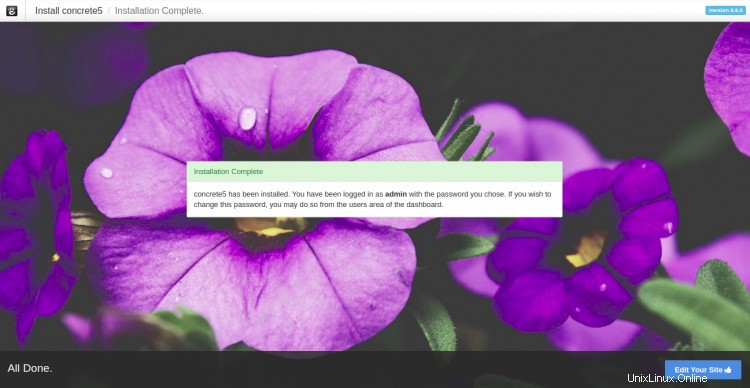Concrete5 es un sistema de gestión de contenido de código abierto que se utiliza para publicar contenido en Internet. Está escrito en PHP y utiliza MariaDB como base de datos. Proporciona un generador fácil de usar que lo ayuda a crear páginas y contenido a través del navegador web. Es flexible, seguro, listo para dispositivos móviles y se basa en la arquitectura Model-View-Controller. Ofrece un amplio conjunto de características que incluyen, editor de contenido WYSIWYG, administrador de medios, arrastrar y soltar contenido, edición en contexto y muchas más.
En esta publicación, le mostraremos cómo instalar Concrete5 CMS con Apache y Let's Encrypt SSL en el servidor Ubuntu 20.04.
Requisitos
- Un servidor con Ubuntu 20.04.
- Un nombre de dominio válido apuntando a la IP del servidor.
- Se ha configurado una contraseña raíz en su servidor.
Cómo empezar
Primero, deberá actualizar el índice del paquete APT a la última versión. Puede actualizarlo con el siguiente comando:
apt-get update -y
Una vez que se actualiza el índice APT, puede continuar con el siguiente paso.
Instalar Apache, MariaDB y PHP
A continuación, deberá instalar el servidor web Apache, el servidor de base de datos MariaDB, PHP y otras extensiones de PHP en su servidor. Puede instalarlos todos usando el siguiente comando:
apt-get install apache2 mariadb-server php libapache2-mod-php libapache2-mod-php php-common php-mbstring php-xmlrpc php-soap php-gd php-xml php-intl php-mysql php-cli php-ldap php-zip php-curl -y
Una vez que todos los paquetes estén instalados, edite el archivo php.ini y configure los valores deseados:
nano /etc/php/7.4/apache2/php.ini
Cambie las siguientes líneas:
file_uploads = On allow_url_fopen = On memory_limit = 256M upload_max_filesize = 64M date.timezone = Asia/Kolkata
Guarde y cierre el archivo cuando haya terminado, luego reinicie el servicio Apache para aplicar los cambios:
systemctl restart apache2
Una vez que haya terminado, puede continuar con el siguiente paso.
Crea una base de datos Concrete5
A continuación, deberá crear una base de datos y un usuario para Concrete5. Primero, inicie sesión en MariaDB con el siguiente comando:
mysql
Una vez que inicie sesión, cree una base de datos y un usuario con el siguiente comando:
MariaDB [(none)]> CREATE DATABASE concrete5;
MariaDB [(none)]> CREATE USER 'concrete5user'@'localhost' IDENTIFIED BY 'password';
A continuación, otorgue todos los privilegios a la base de datos de Concrete5 con el siguiente comando:
MariaDB [(none)]> GRANT ALL ON concrete5.* TO 'concrete5user'@'localhost' IDENTIFIED BY 'password' WITH GRANT OPTION;
A continuación, elimine los privilegios y salga de la consola de MariaDB con el siguiente comando:
MariaDB [(none)]> FLUSH PRIVILEGES;
MariaDB [(none)]> EXIT;
Una vez que haya terminado, puede continuar con el siguiente paso.
Descargar Concrete5 CMS
Primero, vaya al sitio web de Concrete5 CMS, copie la URL de la última versión de Concrete5 y descárguela con el siguiente comando:
wget --trust-server-names https://www.concrete5.org/download_file/-/view/115589/ -O concrete5.zip
Una vez que se complete la descarga, extraiga el archivo descargado con el siguiente comando:
unzip concrete5.zip
A continuación, mueva el directorio extraído al directorio raíz web de Apache usando el siguiente comando:
mv concrete5-* /var/www/html/concrete5
A continuación, establezca el permiso y la propiedad adecuados para el directorio concrete5 con el siguiente comando:
chown -R www-data:www-data /var/www/html/concrete5/
chmod -R 755 /var/www/html/concrete5/
Una vez que haya terminado, puede continuar con el siguiente paso.
Configurar Apache para Concrete5 CMS
A continuación, deberá crear un archivo de configuración de host virtual de Apache para Concrete5 CMS. Puedes crearlo con el siguiente comando:
nano /etc/apache2/sites-available/concrete5.conf
Agregue las siguientes líneas:
<VirtualHost *:80>
ServerAdmin [email protected]
DocumentRoot /var/www/html/concrete5/
ServerName concrete5.example.com
<Directory /var/www/html/concrete5/>
Options +FollowSymlinks
AllowOverride All
Require all granted
</Directory>
ErrorLog ${APACHE_LOG_DIR}/error.log
CustomLog ${APACHE_LOG_DIR}/access.log combined
</VirtualHost>
Guarde y cierre el archivo, luego habilite el host virtual de Apache y el módulo de reescritura con el siguiente comando:
a2ensite concrete5.conf
a2enmod rewrite
A continuación, reinicie el servicio Apache para aplicar los cambios:
systemctl restart apache2
También puede verificar el estado del servicio Apache usando el siguiente comando:
systemctl status apache2
Deberías obtener el siguiente resultado:
? apache2.service - The Apache HTTP Server
Loaded: loaded (/lib/systemd/system/apache2.service; enabled; vendor preset: enabled)
Active: active (running) since Sat 2021-05-15 15:00:03 UTC; 4s ago
Docs: https://httpd.apache.org/docs/2.4/
Process: 15566 ExecStart=/usr/sbin/apachectl start (code=exited, status=0/SUCCESS)
Main PID: 15585 (apache2)
Tasks: 6 (limit: 2353)
Memory: 13.5M
CGroup: /system.slice/apache2.service
??15585 /usr/sbin/apache2 -k start
??15586 /usr/sbin/apache2 -k start
??15587 /usr/sbin/apache2 -k start
??15588 /usr/sbin/apache2 -k start
??15589 /usr/sbin/apache2 -k start
??15590 /usr/sbin/apache2 -k start
May 15 15:00:03 ubuntu2004 systemd[1]: Starting The Apache HTTP Server...
En este punto, el servidor web Apache está configurado para alojar Concrete5 CMS. Ahora puede continuar con el siguiente paso.
Acceda a la interfaz web de Concrete5 CMS
Ahora, abra su navegador web y acceda a la interfaz web de Concrete5 CMS usando la URL http://concrete5.example.com . Será redirigido a la siguiente página:

Seleccione su idioma y haga clic en la flecha botón. Debería ver la siguiente página:

Asegúrese de que todas las bibliotecas requeridas estén instaladas, luego haga clic en Continuar con la instalación botón, debería ver la siguiente página:

Aquí, proporcione el nombre de usuario del administrador, la contraseña, el nombre de usuario de la base de datos, la contraseña y el nombre de la base de datos, luego haga clic en Instalar Concreto5 botón para iniciar la instalación. Una vez completada la instalación, debería ver la siguiente página:


Ahora, haga clic en Editar su sitio botón, debería ver el tablero de Concrete5 en la siguiente página:

Secure Concrete5 con Let's Encrypt SSL
A continuación, se recomienda proteger su sitio web con Let's Encrypt SSL. Primero, instale el cliente Certbot usando el siguiente comando:
apt-get install python3-certbot-apache -y
Una vez instalado, ejecute el siguiente comando para proteger su sitio web con Let's Encrypt SSL:
certbot --apache -d concrete5.example.com
Se le pedirá que proporcione su correo electrónico y acepte el término del servicio como se muestra a continuación:
Saving debug log to /var/log/letsencrypt/letsencrypt.log Plugins selected: Authenticator standalone, Installer None Enter email address (used for urgent renewal and security notices) (Enter 'c' to cancel): [email protected] - - - - - - - - - - - - - - - - - - - - - - - - - - - - - - - - - - - - - - - - Please read the Terms of Service at https://letsencrypt.org/documents/LE-SA-v1.2-November-15-2017.pdf. You must agree in order to register with the ACME server at https://acme-v02.api.letsencrypt.org/directory - - - - - - - - - - - - - - - - - - - - - - - - - - - - - - - - - - - - - - - - (A)gree/(C)ancel: A - - - - - - - - - - - - - - - - - - - - - - - - - - - - - - - - - - - - - - - - Would you be willing to share your email address with the Electronic Frontier Foundation, a founding partner of the Let's Encrypt project and the non-profit organization that develops Certbot? We'd like to send you email about our work encrypting the web, EFF news, campaigns, and ways to support digital freedom. - - - - - - - - - - - - - - - - - - - - - - - - - - - - - - - - - - - - - - - - (Y)es/(N)o: Y Plugins selected: Authenticator apache, Installer apache Obtaining a new certificate Performing the following challenges: http-01 challenge for concrete5.example.com Enabled Apache rewrite module Waiting for verification... Cleaning up challenges Created an SSL vhost at /etc/apache2/sites-available/concrete5-le-ssl.conf Enabled Apache socache_shmcb module Enabled Apache ssl module Deploying Certificate to VirtualHost /etc/apache2/sites-available/concrete5-le-ssl.conf Enabling available site: /etc/apache2/sites-available/concrete5-le-ssl.conf
A continuación, seleccione si desea redirigir o no el tráfico HTTP a HTTPS como se muestra a continuación:
Please choose whether or not to redirect HTTP traffic to HTTPS, removing HTTP access. - - - - - - - - - - - - - - - - - - - - - - - - - - - - - - - - - - - - - - - - 1: No redirect - Make no further changes to the webserver configuration. 2: Redirect - Make all requests redirect to secure HTTPS access. Choose this for new sites, or if you're confident your site works on HTTPS. You can undo this change by editing your web server's configuration. - - - - - - - - - - - - - - - - - - - - - - - - - - - - - - - - - - - - - - - - Select the appropriate number [1-2] then [enter] (press 'c' to cancel): 2
Escriba 2 y presione Entrar para instalar Let's Encrypt SSL para su sitio web:
Enabled Apache rewrite module Redirecting vhost in /etc/apache2/sites-enabled/concrete5.conf to ssl vhost in /etc/apache2/sites-available/concrete5-le-ssl.conf - - - - - - - - - - - - - - - - - - - - - - - - - - - - - - - - - - - - - - - - Congratulations! You have successfully enabled https://concrete5.example.com You should test your configuration at: https://www.ssllabs.com/ssltest/analyze.html?d=concrete5.example.com - - - - - - - - - - - - - - - - - - - - - - - - - - - - - - - - - - - - - - - - IMPORTANT NOTES: - Congratulations! Your certificate and chain have been saved at: /etc/letsencrypt/live/concrete5.example.com/fullchain.pem Your key file has been saved at: /etc/letsencrypt/live/concrete5.example.com/privkey.pem Your cert will expire on 2020-10-23. To obtain a new or tweaked version of this certificate in the future, simply run certbot again with the "certonly" option. To non-interactively renew *all* of your certificates, run "certbot renew" - If you like Certbot, please consider supporting our work by: Donating to ISRG / Let's Encrypt: https://letsencrypt.org/donate Donating to EFF: https://eff.org/donate-le
Ahora puede acceder a Concrete 5 de forma segura utilizando la URL https://concrete5.example.com .
Conclusión
En la guía anterior, aprendió a instalar Concrete5 CMS con Apache y Let's Encrypt SSL en Ubuntu 20.04. Ahora puede publicar su contenido en Internet fácilmente utilizando el CMS de Concrete5. Siéntase libre de preguntarme si tiene alguna pregunta.